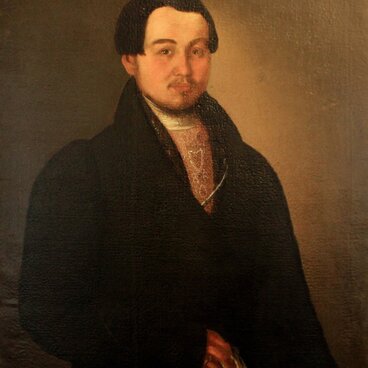The Uglich Museum houses a portrait of Dmitry Yevgenievich Kashkin, a son of Yaroslavl Governor-General. In this painting, Dmitry Kashkin is depicted at the age of about 35 with the Order of St. Anna, 1st class, on his chest. According to Yaroslavl art experts, the portrait could be attributed to the serf artist Ivan Grigoryevich Bubnov.
The Kashkins were an ancient aristocratic family dating back to the Greek “nobleman” Karbush, who arrived in Moscow as part of the entourage of Sophia Palaiologos. The authenticity of the story was confirmed by the House of Genealogical Affairs. Dmitry Kashkin’s grandfather served in the Navy; at the end of his career, he had the rank of vice admiral. His father, Yevgeny Kashkin, was at various times the governor of Vyborg, Perm, Tobolsk, Yaroslavl, Vologda, Tula, and Kaluga. It was he who made a personal report to the Empress about the conspiracy of Mirovich and its outcome, as a result of which he was promoted to the rank of colonel.
Dmitry Kashkin himself received good home education and, while still in his teens, was enrolled in the Preobrazhensky Regiment, participated in the war with Sweden, fought in Poland, and crossed the Alps as part of Suvorov’s Italian and Swiss expedition. After retirement, he settled with his family in his familial estate of Burmasovo near Uglich, where he arranged a theater. In the estate, Dmitry Kashkin, who spoke several languages, worked in his large library, wrote plays, and staged them. According to the contemporaries, the performances were played by serfs, with the master himself playing the parts of ancient gods.
Kashkin survived a chain of dramatic family misfortunes — a criminal conviction, madness and exile of his son, then the death of his wife — and completely immersed himself in writing. He presented his “Soul-Saving and Edifying Christian Teachings for the Young” to Empress Elizabeth Alexeievna, which was followed by a heroic poem “Alexandriada” made up of seven songs dedicated to the reign of Alexander I, as well as “Pious Reflections of a Solitary Christian”, and other writings. Contemporaries also referred to a musical instrument invented by Kashkin — a sort of a gigantic guitar, which he named after himself — “a dimitara”.
The Kashkins were an ancient aristocratic family dating back to the Greek “nobleman” Karbush, who arrived in Moscow as part of the entourage of Sophia Palaiologos. The authenticity of the story was confirmed by the House of Genealogical Affairs. Dmitry Kashkin’s grandfather served in the Navy; at the end of his career, he had the rank of vice admiral. His father, Yevgeny Kashkin, was at various times the governor of Vyborg, Perm, Tobolsk, Yaroslavl, Vologda, Tula, and Kaluga. It was he who made a personal report to the Empress about the conspiracy of Mirovich and its outcome, as a result of which he was promoted to the rank of colonel.
Dmitry Kashkin himself received good home education and, while still in his teens, was enrolled in the Preobrazhensky Regiment, participated in the war with Sweden, fought in Poland, and crossed the Alps as part of Suvorov’s Italian and Swiss expedition. After retirement, he settled with his family in his familial estate of Burmasovo near Uglich, where he arranged a theater. In the estate, Dmitry Kashkin, who spoke several languages, worked in his large library, wrote plays, and staged them. According to the contemporaries, the performances were played by serfs, with the master himself playing the parts of ancient gods.
Kashkin survived a chain of dramatic family misfortunes — a criminal conviction, madness and exile of his son, then the death of his wife — and completely immersed himself in writing. He presented his “Soul-Saving and Edifying Christian Teachings for the Young” to Empress Elizabeth Alexeievna, which was followed by a heroic poem “Alexandriada” made up of seven songs dedicated to the reign of Alexander I, as well as “Pious Reflections of a Solitary Christian”, and other writings. Contemporaries also referred to a musical instrument invented by Kashkin — a sort of a gigantic guitar, which he named after himself — “a dimitara”.


